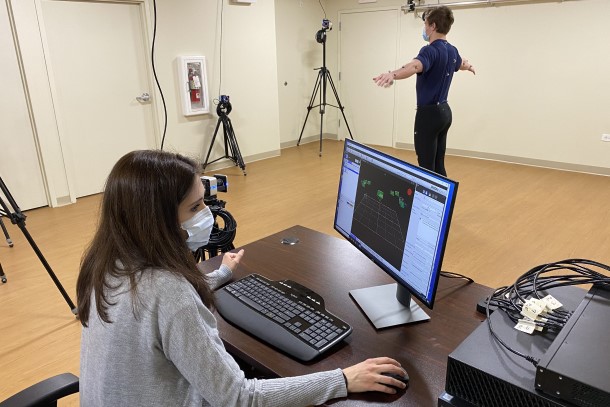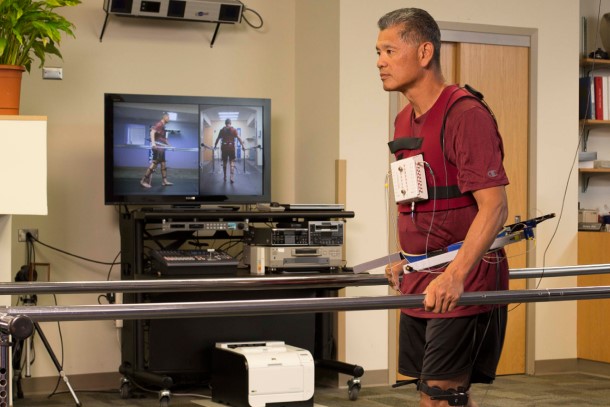
For years, movie and computer-game animators have used motion capture technology to reconstruct a body or create animated characters (think the Hulk from the Marvel movies). MossRehab has been using the same technology, but for more clinical purposes.
Scientists at the Moss Rehabilitation Research Institute (MRRI) and clinicians in the MossRehab Sheerr Gait and Motion Analysis Lab are harnessing motion capture technology to track movements of body segments to understand how the brain controls motion. In fact, MossRehab helped pioneer the use of this technique beginning in the early 1980s.
Amanda Therrien, PhD, director of the MRRI Sensorimotor Learning Laboratory, uses motion capture technology to compare the body movements of healthy individuals to someone with neurological damage to the cerebellum. People with damage to the cerebellum can move but in a highly uncoordinated way where they totter back and forth. This impaired coordination affects body movements such as posture, speech, eye movement, and mobility of the arms and legs.
Analyzing body movements for answers
Motion capture technology enables Dr. Therrien to measure precise movement patterns of different body segments as study participants perform tasks such as reaching for a target or walking.
“With this very nuanced information, I can observe when a person with neurologic damage veers off target during arm motion and compare the movement pattern to that shown by someone who does not have neurological damage,” Dr. Therrien says. “I can use these findings to develop hypotheses about the roles played by the cerebellum in determining impairment. This type of research can ultimately lead to treatment strategies to help these patients move in a more coordinated manner.”
In her research, Dr. Therrien uses an infrared marker motion capture system in which highly visible markers are placed on specific body points as a reference for tracking movements.
“I use an optical system in my lab where motion capture cameras emit infrared light that reflects off markers placed on different body segments and projects as an image back to the camera,” she says. “We can measure full-body movement with infrared marker-based motion capture technology in three-dimensional space, which is a big advancement over previous video and photography techniques that often didn’t have clear signals.”
Researching the loss of imitation skills
We often learn through imitation. However, those with brain injuries may lose the ability to imitate gestures. Aaron Wong, PhD, director of the MRRI Cognitive-Motor Learning Laboratory and scientific director of The Klein Family Parkinson’s Rehabilitation Center, uses motion capture technology to research an area of the brain called the parietal lobe that, when damaged, can result in the inability to copy gestures. “There’s a phenomenon called apraxia that is prevalent in people who have experienced a stroke in the left hemisphere of the brain,” Wong says. “This disorder impacts high-level planning of body movements and affects the ability to imitate moving gestures.”
Researching the disorder involves studying complicated movements in three-dimensional space. Traditionally, research staff videotaped the movements of individuals, then watched recordings to meticulously code gesture quality. Results were qualitative as to whether a person moved the right way. In contrast, motion capture technology provides a rich data set of the actual movement from all joints that enables the detection of more subtle errors.
Dr. Wong implements a magnetic marker system that uses sensors on the body that report positional and rotational information. “Using motion capture technology, we can directly compare movements of an actor to the exact movements produced by a patient when imitating in high-dimensional space,” Dr. Wong explains. “This high-quality quantitative data tells us exactly what is going on during imitation.”
Shailesh S. Kantak, PhD, PT, director of the MRRI Neuroplasticity and Motor Behavior Laboratory, also uses a magnetic marker system of motion capture technology to assess how patients with stroke and other neurological conditions move during goal-directed functional actions. The purpose of the research is to better understand how stroke victims control their movements after recovery.
“Motion capture technology helps quantify patients’ naturalistic actions when performing activities of daily living - such as picking up a cup - on the entire movement as it evolves in real time,” explains Dr. Kantak. “It allows me to study different phases of body movements and understand the strategies that patients use to control them. Clinical assessment tools that rely on observation alone do not allow an objective evaluation of these movements.”
Research findings will provide a better understanding of patient behaviors and variability in movement recovery after a stroke to define the best types of clinical intervention for these patients.
In her research on phantom limb pain,
Laurel Buxbaum,
PsyD, associate director of MRRI and director of the Cognition and Action Laboratory
, is using motion capture technology more similarly to the Hollywood approach by employing magnetic motion tracking to create the motion of an avatar in virtual reality (VR). Using this approach, Dr. Buxbaum is giving amputees their limbs back in a VR system that fills in an image of the missing limbs while people play different therapeutic games. The motion capture sensors pick up the motion of the residual limb above the site of the amputation. The visual feedback of the missing limb helps reduce phantom limb pain.
Patient assessments

In the clinical setting, Daniel K. Moon, MD, physiatrist and gait and movement specialist who works at MossRehab Elkins Park, uses motion capture technology in the Sheerr Gait and Motion Analysis Lab to expand his assessment of patients with gait and disorders of movement. Serving a diverse patient population including those with stroke, traumatic brain injuries and spinal cord injuries, he notes the importance of motion capture technology as an assessment tool to get a more definitive idea of patient needs to improve their mobility.
“Using motion capture technology, I gain information to more precisely quantify the joint angles and limb movements than through observation,” Dr. Moon remarks. “Using data gained through this assessment along with recordings of electrical activity produced by muscles, I can determine which muscles are causing problems for the patient and formulate a treatment plan.”
Similar to Dr. Therrien, he uses an infrared marker motion capture system using markers on certain body points to track movements. “I use motion capture technology with 3D motion analysis and reflective markers to assess how the muscles are acting to generate force or decelerate the joint,” Dr. Moon explains.
In addition to serving patients at MossRehab Elkins Park where the laboratory is located, Dr. Moon conducts assessments of individuals referred from other providers through the Northeast corridor. “Other physiatrists and surgeons are aware of this technology and appreciate the extra feedback when treating their patients,” notes Dr. Moon. “Surgeons who do muscle tendon lengthening or transfer surgeries like to have this additional information prior to surgery.”
Next time you watch Bruce Banner turn into the Hulk in The Avengers, think about how science used at MossRehab and MRRI helped develop new treatment strategies for patients who suffer from brain injuries. Findings from motion capture technology improve protocols used by clinicians to analyze patient movements, reduce pain, and diagnose problems such as challenges with gait.
Learn more about MRRI and the Sheerr Gait and Motion Analysis Laboratory.